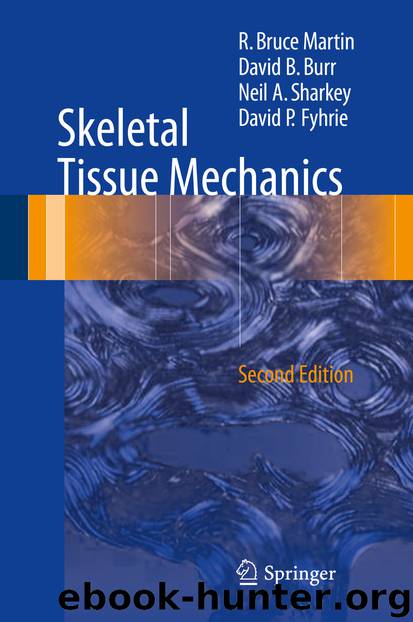Skeletal Tissue Mechanics by R. Bruce Martin David B. Burr Neil A. Sharkey & David P. Fyhrie

Author:R. Bruce Martin, David B. Burr, Neil A. Sharkey & David P. Fyhrie
Language: eng
Format: epub
Publisher: Springer New York, New York, NY
5.3.3 Types of Lubrication
There are several different mechanisms by which lubrication can be achieved. Each of the following mechanisms is thought to play a role in the lubrication of synovial joints.
5.3.3.1 Boundary Lubrication
“All things and everything whatsoever however thin it be which is interposed in the middle between objects that rub together lighten the difficulty of this friction.”
So said Leonardo da Vinci, and while this translation may not win a prize for punctuation, it is perhaps as good a description as any of the idea behind boundary lubrication. Placing a “boundary” layer (i.e., an extremely thin layer, perhaps one molecule thick) of almost any liquid-like material between the bearing surfaces holds the surface projections slightly apart, reduces adhesion, and keeps the projections from interlocking (Fig. 5.15).
Figure 5.15Polymer lubricants (red and blue) between cartilage surfaces (black lines) greatly reduce friction by trapping a water film (water molecules not drawn).
Download
This site does not store any files on its server. We only index and link to content provided by other sites. Please contact the content providers to delete copyright contents if any and email us, we'll remove relevant links or contents immediately.
| Cell Biology | Developmental Biology |
| Entomology | Marine Biology |
| Microbiology | Molecular Biology |
| Biostatistics |
Sapiens: A Brief History of Humankind by Yuval Noah Harari(14252)
The Tidewater Tales by John Barth(12608)
Mastermind: How to Think Like Sherlock Holmes by Maria Konnikova(7227)
Do No Harm Stories of Life, Death and Brain Surgery by Henry Marsh(6891)
The Thirst by Nesbo Jo(6826)
Why We Sleep: Unlocking the Power of Sleep and Dreams by Matthew Walker(6618)
Life 3.0: Being Human in the Age of Artificial Intelligence by Tegmark Max(5474)
Sapiens by Yuval Noah Harari(5294)
The Longevity Diet by Valter Longo(5019)
The Body: A Guide for Occupants by Bill Bryson(4974)
The Rules Do Not Apply by Ariel Levy(4861)
The Immortal Life of Henrietta Lacks by Rebecca Skloot(4525)
Animal Frequency by Melissa Alvarez(4395)
Why We Sleep by Matthew Walker(4360)
The Hacking of the American Mind by Robert H. Lustig(4318)
Yoga Anatomy by Kaminoff Leslie(4306)
All Creatures Great and Small by James Herriot(4232)
Double Down (Diary of a Wimpy Kid Book 11) by Jeff Kinney(4207)
Barron's AP Biology by Goldberg M.S. Deborah T(4097)
